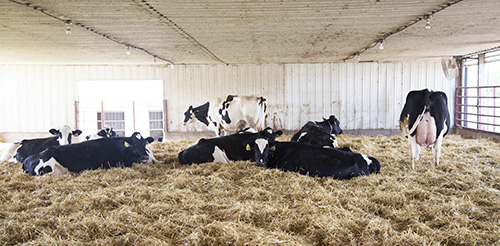
Oftentimes, the diseases and disorders we cannot readily detect are the ones that cost our cows and bottom lines the most. Particularly with Johne's disease, a seemingly fit animal may actually be a super shedder, releasing large number of disease-causing bacteria that can then infect its healthy herdmates.
Johne's is caused by Mycobacterium avium ssp. paratuberculosis (MAP) and results in inflammation and damage to the intestinal wall. This, in turn, affects the cow's nutrient absorption capabilities.
It is estimated that MAP is present in over 90 percent of U.S. herds, noted Heather Dann in the Miner Institute Farm Report. The bacteria are transmitted one of three ways: ingestion of contaminated manure, in utero, or through infected colostrum.
While the infection often takes root within the first six months of life, clinical signs of the disease typically don't manifest until the animal is between 2 and 6 years old. Due to its long incubation period and lack of clinical signs, Johne's disease detection can be quite difficult.
Unlike other subclinical disorders, there is a lack of cost-effective treatment options for Johne's-infected cattle. The disease can also cause substantial economic losses due to premature culling, reduced milk yield, poor fertility and a greater susceptibility to other health problems.
In the U.S., the estimated economic impact of Johne's disease is between $200 million and $1.5 billion annually. Losses associated with the clinical form of the disease range from $200 to $2,300 per case. While the economic impact of subclinical disease is less well defined, it likely ranges between $35 and $72 per cow annually.
One thing is clear though, noted Dann. The economic consequence of Johne's is likely to rise over time in infected herds where control measures are not implemented.
Most control programs use a combination of on-farm risk assessments, testing, culling high-risk animals and implementing biosecurity measures. It's estimated that the cost of control programs is approximately $30 per cow annually. A good return on investment can be expected when considering the cost of subclinical and clinical disease.
In the long term, testing and culling strategies alone fail to eradicate the disease. Strategies that minimize exposure risk have proven to be the most cost-effective control methods.

Amanda Smith was an associate editor and is an animal science graduate of Cornell University. Smith covers feeding, milk quality and heads up the World Dairy Expo Supplement. She grew up on a Medina, N.Y., dairy, and interned at a 1,700-cow western New York dairy, a large New York calf and heifer farm, and studied in New Zealand for one semester.








